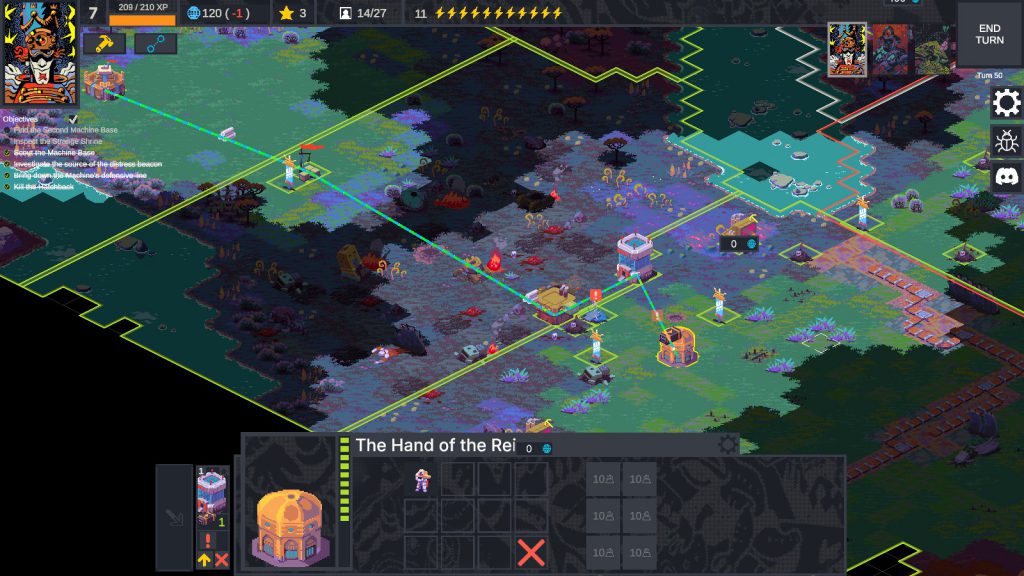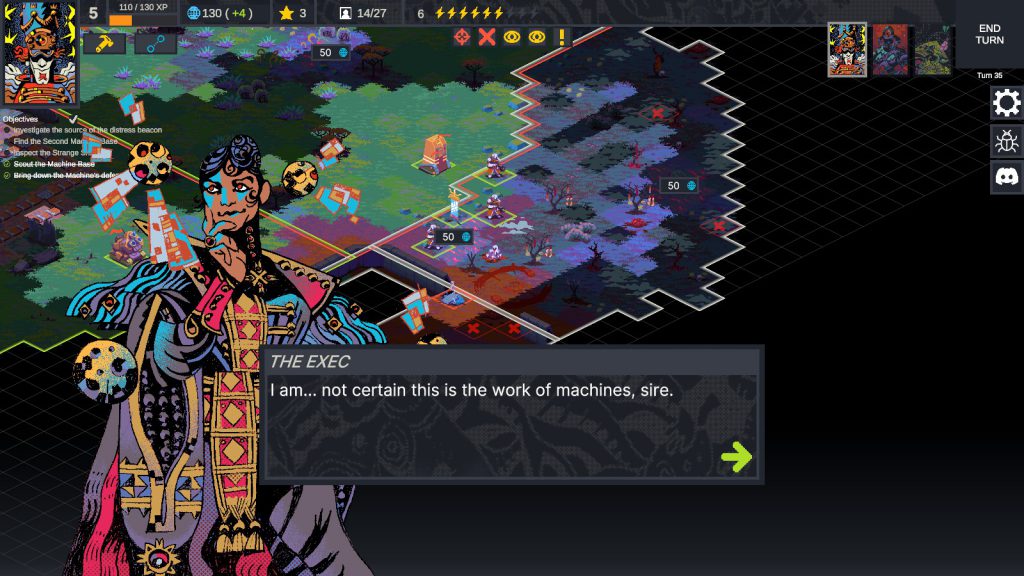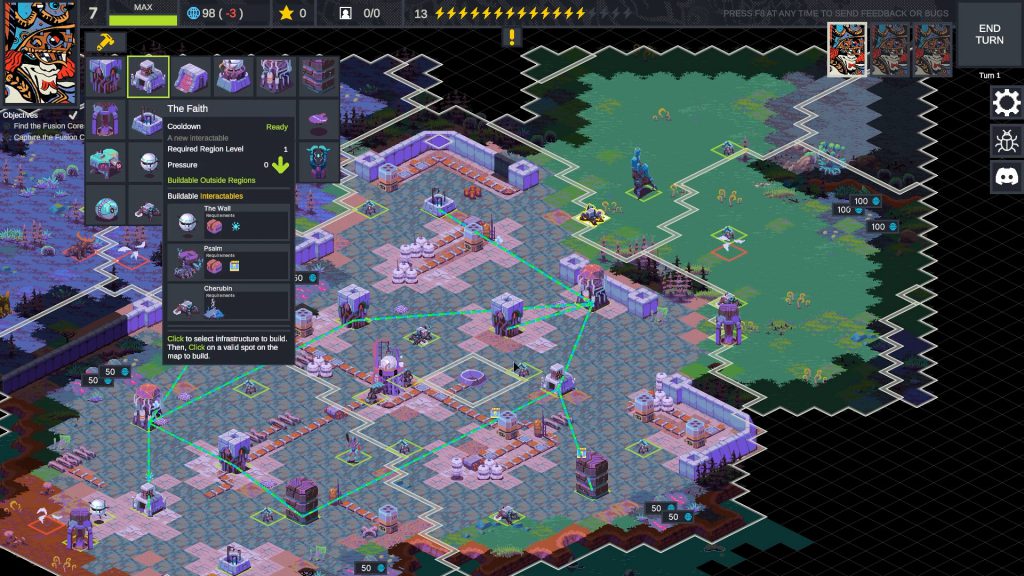Cantata is all about adaptation, supply-lines and strategy
Cantata is a celebration of the decades-long strategy genre, taking a lot of notes from popular real-time and turn-based games and wedging them into a tight 9-point (currently 3-point) campaign that chronicles three varied factions smashing each other into tiny pieces over a failed colony planet with a not-so-hidden secret.
The head of the 111th Reign of Harmony and Prosper is raging, they’re hot on the tails of Vashti, the robot leading the Unified Spirit AI — an AI uprising who recently turned on their human masters. The hot point of the rebellion is coming, and it’s going to take place on Shoal, a failed human colony where a third faction — The People of Sun and Shadow —are desperate to protect their planet god. This conflict between three factions, each driven by a different fuel, be that revenge, self-preservation, or defense, is the heart of Cantata‘s campaign. That’s all you need to know before you drop down to Shoal.
I said in the intro that Cantata takes from the various walks of strategy games over the years, and that’s perhaps best evidenced in three different points: The three varied factions, the resource management and the actual duration of each scenario. You can probably run through each of them in under half an hour, but only in the same way that people can finish Skyrim in less than an hour. For most people, it’ll take hours upon hours. The reason for that is because Afterschool Studio has clearly made the decision to slow everything down and force you to be more deliberate. Most units can only move a handful of tiles (although, there’s a very handy surge mechanic I’ll get to later) and the maps are vast and carefully created. The first scenario, which follows the freshly grounded 111th Reign, tasks you with carefully encroaching past scarred battlefields, through massive robot encampments, then on past ravines and into a further robot base. However, you’re encouraged to wander off course, and if you do so then there are a few little treats to be found, including some of Shoal’s wildlife, a tough close-quarters battle in the former colony and a very brutal introduction to The People of Sun and Shadow who have a bunch of hunters hiding in the mist, ready to shred your conscripts.
Each of the three scenarios that are currently included play out like this. There’s a main route through the level, perhaps a little too main, but absolutely tonnes of rewards and surprises hidden beyond the fog of war. It feels really reminiscent of when older RTS titles would have you complete an objective and then sweep across into unexplored space and show you a teeming enemy base that serves as the level’s main objective — a surprise totally ruined by the minimap back then, but entirely led by your own curiosity here. It’s fun too, and while you’ll definitely have a strategy in mind after playing each faction for a short while, it is always interesting to see how each faction comes up against the other.

The factions are very different. That’s something you probably expect if you play many RTS titles, where games like C&C will have almost entirely different tech trees, even if they operate at roughly the same scale. However, a lot of modern turn-based strategy games and wargames have fallen into the habit of having extremely similar units and buildings, with a few ‘hero’ units to make them stand out. Even more notably, there’s often a ‘race to the finish’, or race to the hero unit, mentality quickly bred in through the campaign. There’s a reason that Order of Battle is probably one of my favourite tactics titles to return to, and that’s because of the sheer variety of units and the advantage and weakness systems at play — although through that it’s almost closer to an RPG with its sheer variables. Cantata has three completely different factions; The machines (Unified Spirit AI) recycle scrap to create their units and even their weakest unit can shred the human (111th Reign) conscripts. The Indigenous faction (People of Sun & Shadow) are vicious in close quarters, attack from the shadows, and can reuse nearly-defeated units to generate new ones. No buildings repeat, and when factions do use the same resource they gather them in completely different ways — a mineable resource from humans is gathered by a specific unit in the Indigenous faction, when they’re not out there on the frontlines transforming units.
Supply logistics and the general flow of things from place to place are at the heart of Cantata. I mentioned that the Indigenous faction can regenerate the nearly-defeated (reduced to ghost-form) units and that the machines can repurpose scrap, well, those things still need to be gathered up. In fact, almost every type of unit requires some degree of a production line or building to create it. The only exception to this is in the case of the Human faction, who can drop-ship down a transport tower that comes loaded with four squishy conscripts (that you’d otherwise create at your HQ). It’s quite costly, but you can drop it almost anywhere on the map and the tower can heal adjacent units, making a WWII-Soviet ‘stream of units to overwhelm a position’ a possibility.

This is the only case where that works though. You can endlessly pummel the conscripts (which can actually level up to gain more health, as well as be stationed Red Alert 2 Sandbags-style to gain some bonuses) into most of the machine installations to eventually overwhelm them. It’ll take hours upon hours though, and there are many more efficient ways to do it.
All non-standard units require at least one resource (besides general ‘mined’ resources) to create, and these are created in dedicated buildings. You then link these buildings up to create a flow of materials between them in whichever way you wish. You can tweak if these buildings create more or less by setting the mineral to spend, meaning you can grind the whole machine to a stop if you are getting low on resources. The thing is, advanced vehicles and units will often require items that have been processed multiple times, and, importantly, just because a unit took five buildings to work in sequence in order to create it doesn’t mean that it’s going to solve all of your problems. A lot of care has gone into making sure that the deadly artillery unit, which still needs three attacks (six turns, as it needs to recharge) to take out some machine buildings, has a very specific radius for attack. If an enemy gets too close to it, same with the sniper units, then it’s game over, and… as it turns out, the Indigenous and Machine factions are very good at getting up close.
Setting up the supply lines is incredibly easy, and it felt really familiar to me. That said, I spent some time thinking about when I’d seen something like that done in a game with its web of interlinked lines and the best example (outside of The Settlers, or other games which require civilians to fuel the resource shift) I could come up with was Trevor Chan’s Seven Kingdoms II, and that was a much simpler version than here.

The main reason it’s much simpler is that Cantata‘s maps are broken into zones. It’s a cool way of doing map capture, and will no doubt be something that really shines when multiplayer becomes the main focus. Each faction claims zones, either through buildings or presence, and once they control the zone they can build in it. Each zone can only have a certain number of buildings in it, meaning that each faction will need to sprawl/crawl/grind their way across the map and claim and defend multiple zones in order to open up the more advanced end of their tech trees. Importantly, smarter players will be able to pull off shock attacks, breaking supply lines, turning the tide of battle and cutting off buildings. Multiplayer should be fun, if not for this reason, then for the fact that there’s a fully-fledged map/scenario creator planned.
Area control is important for other reasons too. There’s an extra resource that I’ve not mentioned so far, and that’s energy. You start with a very small pocket of energy, which renews each turn. This is used in a couple of different ways, including for building, however, its most frequent use is in activating abilities or giving your units an extra move or attack use. Your energy cap increases as you sprawl across the map, which is handy because — as I said earlier — the maps can be quite vast, and if you don’t keep building new logistic loops then you’ll be spending a lot of time moving your units around the battlefield.

What else in Cantata? The character artwork is amazing, like, really amazing; the art style is not at all conventional and immediately memorable. Beyond that, the colour palette used in game — washed out blues, pinks, purples, amplified by yellows and greens — feels like the perfect palette for a strange, alien world.
Cantata clearly has a lot left to show, in the three current scenarios there’s a hint at the world itself playing a role in its defence; from enraged animals, the robots’ secret mission through to the magical trees and shrines that dot the land. It’s also clear from the store page and trailer that there’s room and resources for combat within facilities, on interior-designed maps. While Early Access sometimes feels a little bit cheap, there’s clearly a lot of balancing and refining going on behind the scenes, and there’s already vastly more content included than any demo could handle. Fans of turn-based strategy beware, you could spend a lot of time with Cantata.
Cantata is available now for Windows PC.
Comments are closed.